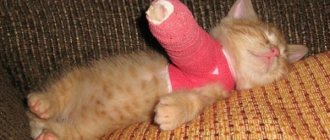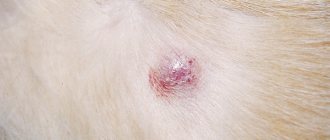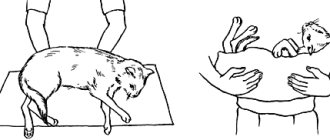The tail is an organ that is quite important for cats. And although they do not use it to climb trees, like monkeys, this organ is used to maintain balance and to convey their mood. Experienced cat lovers know very well that the position and appearance of the tail can tell a lot about the pet’s mood and intentions. So a fracture of a cat’s tail is not the most serious pathology, but it still needs to be treated quickly, without waiting for the organ to take on the appearance of an old poker.
Possible causes of fractures
The tail of a domestic cat is an anatomical continuation of the spine with the presence of small vertebrae, blood vessels and nerve endings. Any damage to this part of the body (fractures, bruises, dislocations, wounds) negatively affects the health of the animal.
Anatomy of a cat's skeleton
Most often, pets are injured at home. If there are small children in the house, the kitten or adult is regularly exposed to dangerous games and pranks. Strongly pulling the tail and tying objects to it leads to various types of injuries and damage. The owner’s task is to explain to the children that they are putting the pet in danger and to protect the cat from little mischief-makers.
In apartment living conditions, curious and annoying cats are often susceptible to tail injuries when doors slam. If an adult steps on it, serious injury to the caudal vertebrae is possible.
A lot of troubles await furry pets outside the living space. First of all, the tail suffers during cat fights with rivals, as well as during defense and fights with enemies, for example, dogs. An animal may fall from a multi-story building or from a tree. In this case, injuries can be of a very diverse nature - from scratches to a serious fracture.
Veterinary specialists identify collisions with animals by vehicles as a separate group of dangerous factors leading to injury to the caudal vertebrae. Cats not only get hit by cars on a busy road, but they are also often run over by inattentive drivers in yards.
The damage in this case is serious and can lead to such undesirable consequences as tail paralysis, accompanied by disturbances in urination and defecation. Such problems are due to the fact that the caudal vertebrae, anus and muscles of the urethra have common nerve branches.
We recommend reading about why a cat is limping on its paw. You will learn about the causes of lameness, the correct actions of owners in this situation, as well as ways to alleviate the condition by veterinarians.
Why don't people like cats in Vietnam?
What is this connected with? There are several opinions.
The sonorous and drawling manner of speech of the Vietnamese, in itself, resembles meowing, and the cat’s “meow” is consonant with the Vietnamese word for “poverty”, so superstitious people, not wanting to listen to constant reminders of the deplorable state of affairs, found a way out - simply cats at home don't start. Therefore, this is not so much a manifestation of personal sympathy as submission to superstition. On the one hand, they can be understood - it’s easy to give up under such parting words. There is another version: the Vietnamese believe that cats imitate a child’s cry with their meows and can lure a person to a dangerous place. But this option sounds far-fetched and unlikely.
In its peculiarity, Vietnam is reminiscent of Egypt: although cats are revered there, the Vietnamese also show a kind of exceptional attention, endowing animals with powers that they do not have.
Signs and symptoms of injury
The presence of characteristic features when the tail vertebrae are damaged in a furry homebody will not raise doubts in the owner that an accident has occurred. The symptoms of a broken tail in a cat are quite pronounced. With this type of injury, fracture and deformation are observed.
A closed injury is accompanied by a displacement of the vertebrae, which is visually assessed as a bulge. In case of open damage, the owner may find vertebrae protruding outward as a result of a violation of the integrity of the skin.
A characteristic symptom of a fracture is severe pain. The animal becomes aggressive, reacts negatively to touch, and does not allow touching. When large nerve endings are damaged, paralysis of this part of the body often occurs. In this case, the injured pet may experience problems with urination and bowel movements.
When broken, the cat drags its tail along the ground, unable to control it. Often a fracture of a cat’s tail is accompanied by loss of sensitivity in the hind limbs, which affects the pet’s movements. They become unsure and coordination of movement is impaired.
Tail dislocation
When a dislocation occurs, the owner usually discovers a change in the shape of the tail due to the displacement of the vertebrae to the sides. The organ appears deformed, sometimes part is folded at an angle to the undamaged area. Sensitivity is reduced. The tissue surrounding the injured part is swollen, edematous, and painful.
A tail bruise is clinically similar to a dislocation. The site of injury is usually swollen, swollen, and tender to the touch.
In addition to fractures and dislocations, the pet’s tail is subject to various injuries, cuts, and violations of the integrity of the skin. At the slightest suspicion of a tail injury, the owner should immediately take the pet to the clinic.
Violation of tissue integrity
Tissue damage resulting from a bite, cut, blow or other injury is visible visually and in most cases does not require hardware diagnostics. If a cat’s tail hurts very badly or the wound is extensive, the pet should be taken to the clinic immediately.
First aid: hydrogen peroxide for disinfection, sterile bandage to stop bleeding and prevent infection. Small abrasions, scratches and other wounds can be treated with any antiseptic ointment (for example, levomekol). But the cat still needs to be shown to a doctor, since even a small scratch can cause infection, tissue necrosis, sepsis and other “delights” of self-medication.
Classification of fractures
Veterinary specialists distinguish several types of fracture of the caudal vertebrae in a cat: closed, open and fracture.
Closed is characterized by the fact that the integrity of the tissues is preserved and no visible wounds are observed. This type of injury is most often diagnosed when an animal is stepped on, pinched by a door, or driven over by a car.
Open fractures are associated with a violation of the integrity of the skin, wounds and damage to surrounding tissues. From the wound, the owner can observe damaged caudal vertebrae. This type of damage is observed during collisions with vehicles, fights with cats and dogs, and falls from a height.
If the fracture occurs at a young age of the pet, when the skeletal system is not formed, a fracture of the caudal vertebrae occurs. In this case, no bone destruction is observed; the vertebrae simply bend under the influence of a traumatic factor.
Diagnostics
Despite the fact that a cat’s tail injury has characteristic features, the owner must immediately take the pet to a veterinarian to clarify the diagnosis and prescribe appropriate treatment.
The specialist’s task is to determine the type of damage and the exact location. For this purpose, the doctor conducts a clinical examination and determines the sensitivity of body parts. If necessary, the animal is given anesthesia and treatment of superficial injuries with antiseptic drugs.
The most informative and reliable method for diagnosing damage to the caudal vertebrae is x-ray examination. To do this, the pet is given sedation or light anesthesia. X-ray allows you to determine the location of the injury and its nature.
As a rule, a fracture is often accompanied by a complex of damage to adjacent tissues and bones. This is especially often observed when a cat is hit by a car or falls from a height. Therefore, the veterinarian conducts a full examination of the animal to identify other, no less serious and dangerous injuries.
Fracture treatment
Therapeutic measures usually depend on the degree of damage to the caudal vertebrae and the location of the wound.
In the event that a violation of integrity occurs closer to the tip, no serious manipulations will most likely be required. If the fracture is open, the fragments of damaged bones are removed first. This type of injury is often accompanied by bleeding, which must be stopped immediately. Removal of fragments and destroyed vertebrae is carried out under local anesthesia.
To prevent wound infection, a course of antibacterial therapy is carried out.
Gypsum
Most often, for fractures and even dislocations of the caudal vertebrae in domestic cats, a fixing bandage or plaster is used. The plaster cast is not very comfortable for the animal, so it is not applied very often. A fixing bandage on the animal's tail has the best immobilizing effect.
The cat rarely takes this kind of manipulation calmly and, when applying a bandage, tries in every possible way to get rid of it. In this case, the owner should purchase a special collar that prevents the animal’s increased interest in the injured part of the body.
A fixing bandage is usually applied for 3 weeks, followed by monitoring of healing using x-ray examination.
To learn how to properly apply a fixation bandage to the tail for fractures, watch this video:
Amputation
A veterinarian usually resorts to such a radical operation as amputation for the following indications:
- Tail paralysis . Such a serious consequence of a fracture requires an immediate surgical solution.
- Open fracture at the base of the tail.
After amputation, the rehabilitation period lasts 2 - 3 weeks. The consequence of injury may be disruption of spontaneous emptying of the bladder and rectum. Restoring these functions may require more time and effort on the part of the owner. The animal needs regular bladder massage and assistance with bowel movements.
A cat's tail fracture: how you can help an injured pet at home
Every cat owner tries to protect it from all kinds of diseases and injuries, but, unfortunately, this is not always possible. Among the many health problems encountered in a furry pet, injuries and even tail fractures occur quite often.
Symptoms: how to determine if there is a problem
The cat has a swollen paw and is limping: what to do?
The fact that something is wrong with a cat’s tail will be visible to the naked eye. A crease or unnatural bend will be visible at the site of injury. Also, often when injuries occur, the innervation is disrupted, and the animal is unable to move the injured part.
The main signs of possible problems with a cat's tail are:
- visually noticeable fracture or disruption of integrity;
- pain when trying to touch the animal;
- traces of a bite, injury or infection are visible on the tail;
- a clearly noticeable inflammatory process and an increase in temperature, which can be detected even with a simple touch;
- the damaged part of the tail swells and swells;
- the tail hangs unnaturally;
- an open injury in which the bones are gaping;
- ensuing paralysis;
- problems with motor function of the legs are noticeable;
- problems with the toilet (either urinary and fecal incontinence appears, or the cat cannot defecate on its own).
An examination by a specialist will help you understand whether there is a fracture or whether it is a simple bruise.
How to distinguish a fracture from a tail bruise
A cat's tail fracture is accompanied by severe pain. Whenever you try to feel the tail, she will start screaming and struggling, but with an ordinary bruise this does not happen.
What does a cat’s tail “say”: let’s look at all the positions
In addition, with a fracture and damage to the integrity of the vertebrae, the deformation of a certain part is clearly visible, which is not observed with a bruise.
For your information! Bruises occur much less frequently than fractures, since the vertebrae in the animal’s tail are very delicate and are easily damaged when subjected to strong pressure.
Diagnosis of tail fractures
Urinary incontinence in a cat: what to do at home
A cat's tail fracture must be diagnosed by a doctor. Even if the damage is obvious, the specialist must find out which part of the tail is damaged and assess how serious the pet’s general condition is. And based on the results of the examination, an individual decision is made on the methods and methods of treatment.
Most often, the veterinarian will need to take an x-ray to make a correct diagnosis. This will allow you to more accurately determine the location and extent of the injury.
If the animal's symptoms are more severe, then if there is a problem with the motor ability of the hind legs or with stool, blood and urine tests, as well as an ultrasound, will have to be done. This will make it possible to assess the risks and prognoses for the health and life of the animal. In addition, this can exclude the presence of damage to other nearby organs, for example, a fracture of the sacrum.
With a complicated fracture, the cat will not be able to sit or move around.
Is it possible to treat on your own?
Many pet owners who have encountered the problem described remember their confusion in the first minutes when they discovered that the cat’s tail was broken and were at a loss what to do. You need to realize that if we are talking about a fracture, then you cannot do without the help of a specialist. It is the veterinarian who will make the correct diagnosis and prescribe the necessary treatment.
At home, you can try to treat a dislocation yourself (if you are confident in the diagnosis) or a fracture not complicated by displacement. In this case, a tight bandage of a special fixing bandage is applied to the damaged area, which will protect it from unnecessary movements. The bandage is applied for 3 weeks.
But in this case, you need to be prepared for some problematic issues that arise during treatment: it is rarely possible to apply a bandage tightly enough, a sick cat can scream and struggle, and remove the fixing bandage on its own (in this case, experts recommend putting a special collar on the animal).
Is it always necessary to treat
Veterinary specialists do not always resort to amputation or plaster for injuries to the caudal vertebrae. If the fracture of the cat's tail is closed and is not accompanied by displacement of the vertebrae, the damage occurred far from the base, the injury can heal on its own. However, the owner should take the pet to a specialized facility to rule out serious damage and seek advice.
We recommend reading about how to treat a cat’s wound after a fight. From it you will learn about the consequences of injuries, when treatment is needed and what kind, as well as when you can let the situation take its course, advice on nutrition rules for a speedy recovery. And here is more information about what to do if a cat scratches its ear until it bleeds.
Prevention
Experts recommend the following rules for preventing injuries to the tail vertebrae in domestic cats:
- Be careful when handling the animal, do not pull or catch the cat by the tail.
- Limit your pet's access to the street.
- Have a conversation with the children about the importance of a cat’s tail and the inadmissibility of pranks on the animal.
- Provide heavy doors with a soft closing mechanism.
- Prevent the animal from jumping and falling from a height.
Fractures and other injuries to the tail of furry pets are not uncommon. Characteristic signs allow owners to accurately identify injury to the tail vertebrae. A timely contact with a veterinarian will allow you to provide the animal with qualified assistance with the least damage to health.
Similar articles
- The cat is limping on a paw (back or front), paw...
The causes of sudden lameness in a pet are most often injuries such as bruises, dislocations, sprains and torn ligaments. ... Tail fracture in cats and cats: symptoms and treatment. Read more - Cat tangles: how to get rid of them and avoid recurrence
Tail fracture in cats and cats: symptoms and treatment. How to prepare a cat for castration. Marina (content manager). Read more
- The cat scratched its ear until it bled: what to do if it itches...
All Diseases and ailments Kidney and intestinal diseases Internal diseases Parasites and fungus Injuries and surgeries Interesting things about cats Maintenance and care Obstetrics ... Tail fracture in a cat: symptoms and treatment. Marina (content manager). Read more
- The cat’s tumor has opened or burst, broken through...
All Diseases and ailments Kidney and intestinal diseases Internal diseases Parasites and fungus Injuries and surgeries Interesting things about cats Maintenance and care Obstetrics ... Tail fracture in a cat: symptoms and treatment. Marina (content manager). Read more
- How to remove a catheter from a cat and install a new one, how long does it...
All Diseases and ailments Kidney and intestinal diseases Internal diseases Parasites and fungus Injuries and surgeries Interesting things about cats Maintenance and care... To prevent loss, the catheter is attached to the pet's tail in this way... Read more
Why can't you pull a cat's tail?
“Don’t pull the cat by the tail” - this figurative expression is often heard by those who are procrastinating on an important matter. But sometimes this action is carried out literally: the tails of pets are regularly attacked by children and older hooligans
What are the dangers of such “pranks” and why you shouldn’t pull a cat’s tail - let’s look at these questions in detail.
The meaning of the tail in the life of cats
To understand the dangers of pulling a cat's tail, it is important to understand the basic functions of this part of the body. It is necessary for a full-fledged cat’s existence and performs the following tasks:
- serves as a balance regulator when jumping and moving in height;
- if you fall, it helps you “steer out” and fall straight on your paws, avoiding injury;
- is a means of communication: through movements of the tail, the cat communicates with its relatives and expresses its emotions towards its owners.
There are breeds whose standard implies a short tail or almost no tail. For example, tailless Manxes have 2–3 tail vertebrae (while most breeds have 20–27).
These cats have more developed hind limbs, which partly compensate for their natural taillessness. If an animal loses its tail in adulthood, its motor and communication functions will be impaired.
Spine part
Cat owners know how carefully their pets treat their own tail, protecting it from careless touches of guests and household members. And this is no coincidence, because the tail contains many nerve endings necessary for the normal functioning of the animal.
Even the slightest injury in this area causes unbearable pain to the pet. For this reason alone, for caring owners, the answer to the question of whether it is possible to pull a cat’s tail is obvious.
In addition, it should be borne in mind that the tail is an extension of the spine. It consists of individual vertebrae that are connected to each other by cartilage and joints that provide mobility.
It is necessary to pay attention to the fact that cats are not docked for aesthetic purposes, like dogs. Any damage to this area compromises the functioning of the animal's nervous system.
The health consequences can be quite serious, including complete loss of sensation in the back of the body.
If you pull a cat's tail, it may "shit"
In search of an answer to the question of what will happen if a cat is pulled by the tail, many have probably come across the popular belief that the animal will then begin to “shit anywhere.” You shouldn’t brush this off as ridiculous superstitions about empty buckets and haircuts during pregnancy.
In this case, the conclusion of “collective intelligence” has good grounds. As mentioned above, the tail is part of the spine, and damage to the spinal column can cause complete or partial paralysis of the lower extremities, fecal and urinary incontinence.
If your cat was regularly subjected to unceremonious treatment by members of the household, and then suddenly began to relieve himself outside of specially designated places, you should not be angry with him, much less punish him. Perhaps these are the consequences of a spinal injury resulting from a sharp tug on the tail.
When should you contact a veterinarian?
Serious damage to the tail is usually visible to the naked eye. You should seek veterinary help if your pet has the following symptoms:
- visible break or break in the tail area;
- painful reaction to touch;
- the tail is hot and inflamed, there is severe swelling;
- problems with the hind limbs, loss of balance, gait disturbance;
- the animal is unable to support its tail, it hangs like a whip;
- loss of previously formed neatness skills: involuntary defecation or urination.
Injury Prevention
As you know, any disease is easier to prevent than to treat. Therefore, in conclusion, let’s talk about preventive measures.
- Be careful when handling the animal. If you need to catch him, don't grab his tail - it's dangerous!
- Limit your pet's access to the street. If you have a private home, equip heavy doors with a soft-closing mechanism.
- Explain clearly to children and other family members why it is wrong to pull a cat's tail, using arguments appropriate to their level of understanding.
- If the baby is very small, do not leave the cat alone with him: this can be dangerous not only for the pet, but also for the child himself.
And remember, we are responsible for those we have tamed. Develop in children love and compassion for all living things from an early age - this will make them more responsible and happy!











